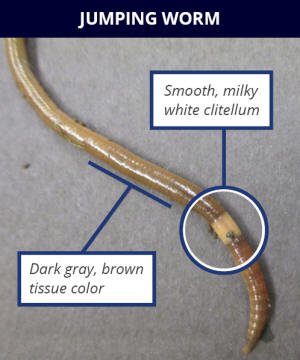|
 These worms are known to change the soil structure, deplete
available nutrients, damage plant roots, and alter water-holding
capacity of the soil. This is especially a concern in our
forests, where organic matter is limited. It is important to
stop the spread of jumping worms. These worms are known to change the soil structure, deplete
available nutrients, damage plant roots, and alter water-holding
capacity of the soil. This is especially a concern in our
forests, where organic matter is limited. It is important to
stop the spread of jumping worms.
Appearance

These jumping worms are 4 to 8 inches long. They have a dark,
metallic body that is darker on top than the bottom. A
characteristic smooth milky, white band called the clitellum
completely encircles the worm's body, unlike other earthworms
with a pink, raised band. When handled, these worms will "jump"
and thrash wildly. They move quickly in a snakelike manner and
can shed their tails when threatened.
What to look for
Jumping worms are found in leaf litter and the top couple of
inches of soil. Start looking for them in mid to late summer.
Soil that looks like coffee grounds is a sign that jumping worms
are present. One way to determine whether jumping worms are
present is a mustard pour.
Mix a gallon of water with 1/3 cup of ground yellow mustard
seed. Pour the mixture slowly onto the soil. This will drive the
worms to the surface and does not harm plants.
Hardiness
Adults jumping worms cannot survive the cold winters of Central
Illinois. However, the very small, dark egg casings persist
through the winter. Jumping worms are parthenogenic, which means
that a single jumping worm can reproduce by creating viable egg
casings.

Damage
Jumping worms are voracious eaters, which causes them to grow
twice as fast as other earthworms. This feeding changes the soil
structure, altering the soil's water holding capacity and
depletes the amount of nutrients available to plants. They also
damage roots severely, causing weaker plants that are more
susceptible to pests, drought, and disease.
Management
There are currently no viable control measures for jumping
worms. Removing adult jumping worms to decrease the number of
egg casings produced is the best control available at this time.
Adults placed in plastic bags and left in the sun die quickly.
Dispose of the bag in the trash.
Prevention is the key
The good news is that there are measures each of us can take to
stop the spread.
Thoroughly clean tools, shoes, and vehicles when moving from one
site to another.
· Only purchase compost, mulch, or other organic matter that has
been heated to appropriate temperatures and duration to reduce
the spread of pathogens, insects, and weeds. Jumping worm egg
casings do not survive temperatures over 104°F
Follow Plant Sharing Best Practices
Do Not buy jumping worms for bait, vermicomposting, or gardens.
University of Illinois Extension Horticulture Educator Nicole
Flowers-Kimmerle is working with Extension Specialists and
University of Illinois Plant Clinic to educate the public on
this invasive species. Additional information can be found on
Nicole’s ILRiverHort blog at extension.illinois.edu/blogs/
ilriverhort or you can email Nicole at
nflower2@illinois.edu.
[to top of second column] |

Stop the spread
Thoroughly clean tools, shoes, and vehicles when moving from one
site to another.
Only purchase compost, mulch, or other organic matter that has been
heated to appropriate temperatures and duration to reduce the spread
of pathogens, insects, and weeds. Jumping worm egg casings do not
survive temperatures over 104°F
Remove adult jumping worms. Place adults in a plastic bag and leave
in the sun at least 10 minutes. Dispose of the bag in the trash.
Remove soil from all plants before transporting them.

Wash roots by completely submerging plant roots in water and washing
away remaining soil. Water is enough to remove soil and other
materials from the roots.
Buy bare-root plants when possible.
Do Not buy jumping worms for bait, vermicomposting, or gardens.
Follow Plant Sharing Best Practices
Best Practices for Sharing Plants to Stop the Spread of Invasive
Species
Only accept plants
From gardeners that have looked for jumping worms
That don't come from an area known to have jumping worms.
If there is no evidence (like soil that resembles coffee grounds) to
suspect there are jumping worms at the site that produced these
plants/materials.
Use these practices to prevent their spread:
Remove soil from all plants before transporting them
This limits the spread of weeds and worms by removing most earthworm
egg cases or weed seeds.
Wash roots
Completely submerge plant roots in water and wash away remaining
soil.
Actively look for worms.
Once clean, protect roots for transportation and sale.
Water is enough to remove soil and other materials from the roots.

Sell bare-root plants when possible.
Repot with clean potting soil
If plants must be sold in soil, repot with sterile potting soil.
The best way to ensure clean soil is to purchase, from a reputable
dealer, bagged and weed and pathogen-free potting soil.
Inspect mulch for signs of jumping worms
Do not use mulch, backyard compost, leaves, or other material that
may harbor jumping worm eggs or weed seeds.
Purchase materials from are a reliable source.
Consider waiting to add materials to the garden to determine if
signs of jumping worms develop
Reduce chances of contamination
Gather and transport plants ready for sale on surfaces like
concrete, tarps, or trays where the newly potted plants cannot pick
up contaminated soil, leaves, or mulch.
Thoroughly clean garden tools and shoes after use.
[Anita Wilkinson
Communications Program Coordinator
UNIVERSITY OF ILLINOIS EXTENSION] |